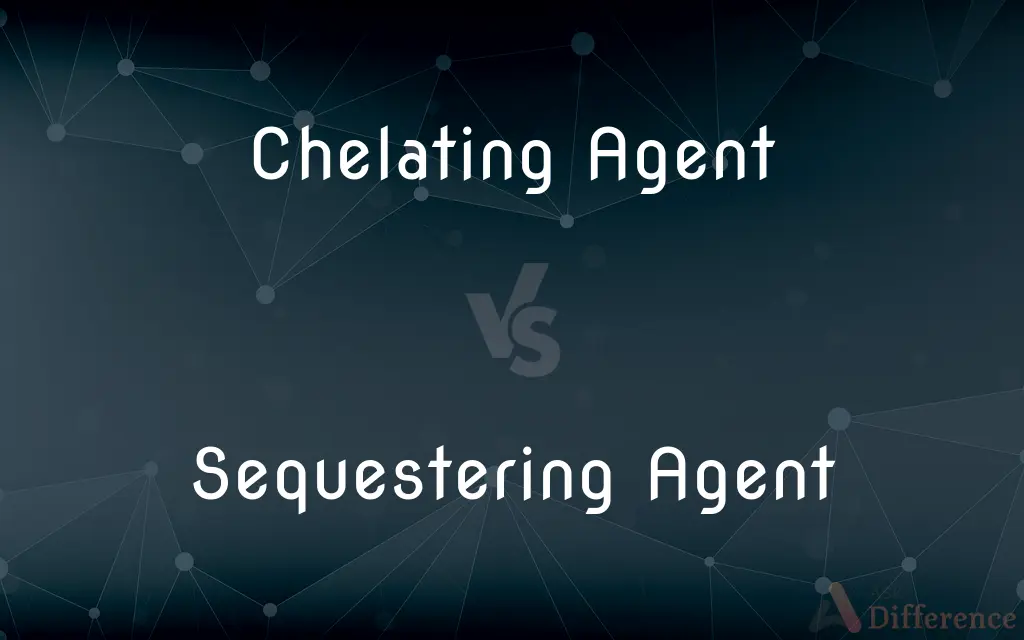Chelating Agent vs. Sequestering Agent — What's the Difference?
By Tayyaba Rehman — Published on January 2, 2024
Chelating agents are chemicals that form multiple bonds with a single metal ion, effectively inactivating it, while sequestering agents trap metal ions by forming weaker, reversible bonds, preventing undesired reactions.

Difference Between Chelating Agent and Sequestering Agent
Table of Contents
ADVERTISEMENT
Key Differences
Chelating agents, like EDTA, chemically bind to metal ions through multiple bonds, creating a stable complex that deactivates the metal ion's reactivity. Sequestering agents, such as citric acid, bind to metal ions more loosely, preventing them from participating in chemical reactions without forming a stable complex.
The binding mechanism of chelating agents involves the formation of ring-like structures with the metal ion, rendering it chemically inert. Sequestering agents trap metal ions but do not necessarily deactivate them, instead limiting their availability in a solution.
Chelating agents are used in medical treatments to remove excess or toxic metals from the body and in industrial applications to manage metal ions' reactivity. Sequestering agents are commonly used in water treatment, food preservation, and detergent formulation to bind with minerals and enhance product effectiveness.
The effectiveness of a chelating agent is measured by its ability to form a strong and stable complex with metal ions. For sequestering agents, the effectiveness lies in their capacity to bind with a variety of ions, reducing their concentration in the solution.
Chelating agents are crucial in biochemistry for their ability to control metal ions' reactivity in biological systems. Sequestering agents find widespread use in consumer products where controlling metal ions' presence improves product stability and performance.
ADVERTISEMENT
Comparison Chart
Binding Mechanism
Forms stable, multiple bonds with a metal ion.
Forms weaker, reversible bonds with metal ions.
Effect on Metal Ions
Deactivates and renders metal ions inert.
Traps metal ions, limiting their reactivity.
Common Uses
Medical treatments, industrial applications.
Water treatment, food preservation, detergents.
Measurement of Effectiveness
Ability to form strong, stable complexes.
Capacity to bind with various ions.
Chemical Structure Interaction
Often forms ring-like structures with ions.
Does not necessarily form stable complexes.
Compare with Definitions
Chelating Agent
They form multiple bonds with a single metal ion.
The chelating agent effectively captured calcium ions, preventing them from forming deposits.
Sequestering Agent
Sequestering agents enhance product effectiveness by controlling metal ions.
The sequestering agent in the shampoo helped in maintaining its efficacy in hard water.
Chelating Agent
It is used to deactivate metal ions in various chemical processes.
In our experiments, a chelating agent was used to inhibit metal-catalyzed reactions.
Sequestering Agent
They trap metal ions, reducing their concentration in solutions.
In the cosmetic formulation, a sequestering agent was used to stabilize the product.
Chelating Agent
A chelating agent forms stable complexes with metal ions.
EDTA, a common chelating agent, is used to treat lead poisoning by binding to lead ions.
Sequestering Agent
It is commonly used in detergents to soften water by binding calcium and magnesium.
The detergent’s sequestering agent prevented mineral buildup in the washing machine.
Chelating Agent
Chelating agents are crucial in controlling metal ion activities in biochemistry.
The chelating agent helped maintain the balance of essential metal ions in the cell culture.
Sequestering Agent
A sequestering agent binds to metal ions, limiting their reactivity.
Citric acid, a natural sequestering agent, is used in food preservation.
Chelating Agent
Chelating agents are used in industrial cleaning to bind metal ions.
In the cleaning process, a chelating agent was added to remove metal ion contaminants.
Sequestering Agent
Sequestering agents are essential in water treatment processes.
A sequestering agent was used in the water plant to manage iron content in the water.
Common Curiosities
Can sequestering agents remove metal ions from water?
Yes, they bind with metal ions, reducing their concentration in water.
Are chelating agents biodegradable?
Some chelating agents are biodegradable, but many synthetic ones are not.
Do sequestering agents form stable complexes like chelating agents?
No, they form weaker, reversible complexes.
What is a primary use of chelating agents in medicine?
They are used to treat heavy metal poisoning by binding and deactivating the metals.
Is EDTA a chelating or sequestering agent?
EDTA is a chelating agent.
Can chelating agents be used in agriculture?
Yes, particularly in treating soil and water with heavy metal contamination.
Do chelating agents have applications in industrial cleaning?
Yes, they are used to remove metal ion deposits in industrial cleaning.
Are all sequestering agents safe for human consumption?
Most used in food and consumer products are safe, but their safety depends on concentration and context.
Are sequestering agents used in cosmetics?
Yes, they are used to stabilize cosmetic formulations.
Can chelating agents be used in water purification?
Yes, particularly in treating industrial wastewater.
Are sequestering agents used in food preservation?
Yes, they help stabilize food by binding with metal ions.
Do sequestering agents have a specific taste or smell?
Most sequestering agents do not significantly alter taste or smell.
Can sequestering agents soften hard water?
Yes, by binding with calcium and magnesium ions.
Is citric acid a chelating agent?
Citric acid acts more as a sequestering agent.
Are chelating agents environmentally friendly?
Their environmental impact varies; some can be persistent pollutants.
Share Your Discovery

Previous Comparison
Exit(0) vs. Exit(1)
Next Comparison
Expenses vs. ExpenditureAuthor Spotlight
Written by
Tayyaba RehmanTayyaba Rehman is a distinguished writer, currently serving as a primary contributor to askdifference.com. As a researcher in semantics and etymology, Tayyaba's passion for the complexity of languages and their distinctions has found a perfect home on the platform. Tayyaba delves into the intricacies of language, distinguishing between commonly confused words and phrases, thereby providing clarity for readers worldwide.














































